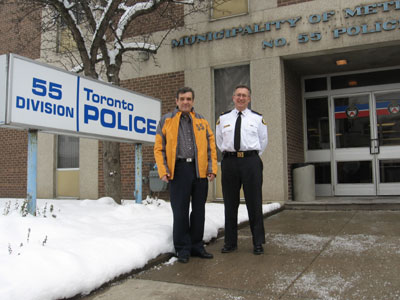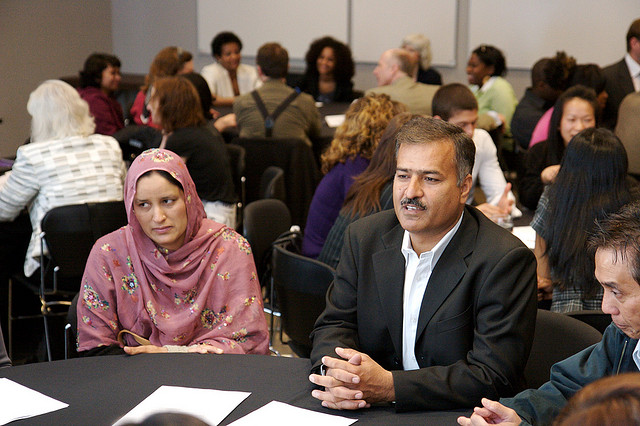As always, Gene Domagala is the perfect person to make connections. With the date for my photo exhibition rapidly approaching and the need to finalize my articles and get the photos ready, I had not planned to do any further interviews, but Gene suggested that one organization could not be missing from my article series about the Beach: Toronto Police Service 55 Division, an organization with whom all the special events organizers work regularly. In his words 55 Division is extremely supportive of the Beach and a very positive force in the community.
Gene made a phone call to the station, and within minutes of the phone call I hopped in my car to drive to Dundas and Coxwell Avenues to meet the officers at 55 Division. Gene introduced me to Superintendent Wayne Peden, the head of the station and after introducing the Celebrate Toronto project Superintendend Peden started to give me a general overview of 55 Division. He explained that the policing area of 55 Division extends from the Don River in the west and to Victoria Park Avenue in the east, and from Danforth Avenue in the north to Lake Ontario in the south.
Superintendent Peden added that the police play a critical role in all the public events in the Beach, including the Beaches Jazz Festival, the Easter Parade and the Ashbridges Bay Fireworks. He used to work in this area in the 1980s and was just transferred back to this station last year. According to Superintendent Peden the Beach is a very safe area, with the main concerns being traffic and parking. He described the Beach as an excellent place to live and work. Many police offers want to work at this station, and Superintendent Peden enjoys his new location.
55 Division has about 235 employees including front line officers, detectives and investigative offers as well as community response officers who work with the community to resolve issues. Examples could include barking dogs, or driveway disputes, or teenagers that might be up to mischief. The idea is to resolve issues before they become problems.
During big events 55 Division officers work with the organizing committees of the respective events to ensure that the festival or the parade are going to run smoothly with minimal inconvenience to the locals. During major events for example, all the main streets north and south of Queen Street East have to be blocked off, and this is 55 Division’s responsibility. Once the roads are closed, the organizers take over and handle things from there.

Gene Domagala with Superintendent Wayne Peden
Superintendent Peden started to fill me in on some of the community issues that are going on in 55 Division: from volleyball programs for teenagers from at-risk communities to school safety and anti-bullying education programs, officers from 55 Division are involved in a wide variety of community endeavours about which I would shortly learn more. The Superintendent added that his station has a very good working relationship with the community and the politicians in the area. 55 Division strives to provide a strong visible presence and to be recognized as an integral part of the community.
As he had to go, Superintendent Peden handed me over to Sergeant John Spanton who was going to explain things to me I more detail. He explained that there are several different units within 55 Division: a Primary Response Unit (PRU) that involves first line policing, emergency call response and apprehension of criminals. In addition community problems and outreach is handled by the Community Response Unit (CRU). Sergeant Spanton added that the division has one officer who is in charge of educational outreach in elementary schools; in addition two full-time officers handle the liaison with local high schools.
One of the important mandates of the Toronto Police Service is to encourage greater community integration. In addition a concerted effort has been made to attract more visible minorities and women into the police force. Sergeant Spanton explained that today many of the officers that are being hired are quite a bit older than what used to be the case in the past. The recruiting process takes life experience into consideration, and Toronto’s demographic diversity is increasingly being reflected in the faces of the Toronto Police Service. A wide variety of different ethnic and cultural groups are represented within Sergeant Spanton’s own team of officers. More officers with different language skills are being hired as well to be able to communicate with the various immigrant groups that call Toronto their home.

Regina La Borde, Elementary School Liaison Officer
Another officer joined us: Regina La Borde is a 15-year veteran with the Toronto Police Force and now a full-time Elementary School Liason Officer. After many years of front-line policing she has become a full-time educator and crime prevention officer for 55 Division. Her curriculum includes topics such as traffic safety rules and not talking to strangers which are taught to children in junior and senior kindergarden. In Grade 2 safety and street proofing continues. Topics such as what to do when you get lost and telling your parents at all times where you are and what you are doing get covered. The curriculum for Grade 4 includes Internet safety and cyber-bullying. The concept of never talking to any strangers, even online, is emphasized as well.
In Grade 5 bullying becomes the key topic while drug awareness takes centre stage in Grade 6. Students learn about the different types of drugs, such as alcohol, marijuana, cocaine or ecstasy; they also get educated about the drugs’ biochemical effects as well as about the legal consequences that can happen if they get involved in drug use. In Grade 8 the focus is on youth violence and gangs to prepare students for what they might be facing in high school. Materials such as videotapes and Powerpoint presentations are used to illustrate the concepts, and the entire curriculum is presently being updated to reflect current realities.
Officer La Borde indicated that she does these teaching assignments in uniform and added that her job is very rewarding because at this age children are very open to learning, and they have a consistently positive image of the police.
Sergeant Spanton continued that police officers come out to local elementary schools in the division to participate in fair days or fun days. Community Response Unit officers make an appearance in uniform and give the children an opportunity to explore the features of a police car and to get to know the officers. On various occasions children from different daycare services have a chance to get a tour of the police station. All these functions are part of the public outreach and education function of the police.
He went on to explain that two full-time officers in 55 Division are dedicated to the local high schools. They make an appearance at high school basketball games or swim meets, and often police officers participate in friendly competitions with the local high school sports teams. The children have a great time competing against the officers, and it gives them a chance to get to know the officers from a human point of view.
In elementary schools officers also offer bicycle safety courses and provide safety checks for the children’s bikes, another opportunity to see the human side of the officers. The focus in elementary schools is on crime prevention and pro-activeness while in high school the police officers’ role becomes more reactive and focused on education and enforcement.

Shoe-shining station in the basement
Sergeant Spanton also explained that in addition to the CRU (Community Response Unit) officers there are Primary Response Unit officers who handle emergency calls and apprehend criminals. A full-time Crime Prevention Officer interacts with local store owners and residents about how to safety-proof homes and businesses. A Community Relations Officer looks after seniors and mentally ill individuals. These officers often become the liaison person with other social service agencies or local hospitals.
Sergeant Spanton himself supervises a Community Response Unit team, and in the winter he has eight officers reporting to him while the number goes up to ten officers in the summer. He also attends management meetings to identify problem areas in the division which will then be taken into account in the deployment of manpower. Special events and crime “hot spots” are considered in the allocation of resources. The officers’ hours are changed depending on the problems that may arise in the community. In the spring as daylight gets longer, work hours for many officers are changed to go from 4 pm to 2 am.
He also explained that many officers walk the beat in the Beach all year round. they start at Lee and Queen and talk to store owners about crime and safety. When the weather gets nice several officers are deployed on bicycles to patrol the green spaces and parklands close to the waterfront to ensure that the general public is safe in these popular recreational spaces. The “Parks Project” for example is intended to provide police presence in the outdoor recreational areas and to deal with groups of teenagers that might assemble in the evenings which occasionally may lead to trouble.
A visible police presence discourages these crowds from gathering, and the officers educate and encourage the youth to disperse when it gets dark to prevent issues from happening. As a result, single women going jogging can feel quite feel safe and secure when they choose to work out in these areas, and a consistent police presence goes a long way towards ensuring public safety. Sergeant Spanton emphasized that the Beach gets the service it gets because it is receptive to the police. He added “we are here to help”.

Sergeant John Spanton and Staff Sergeant Steve Tracy




